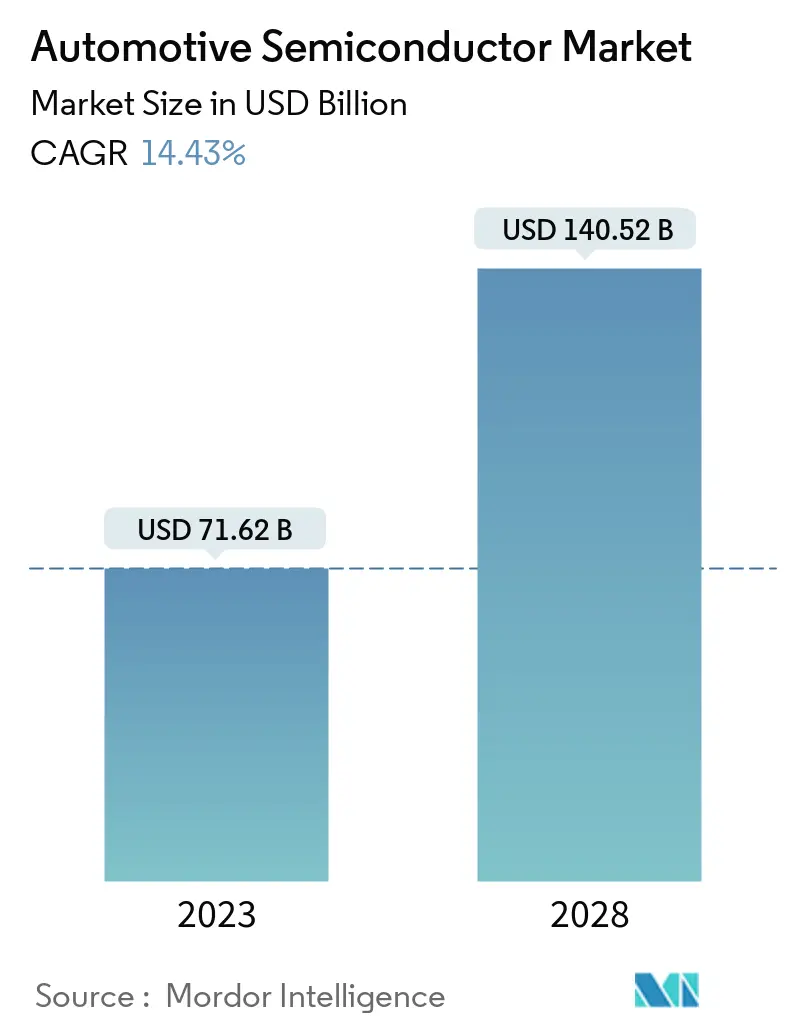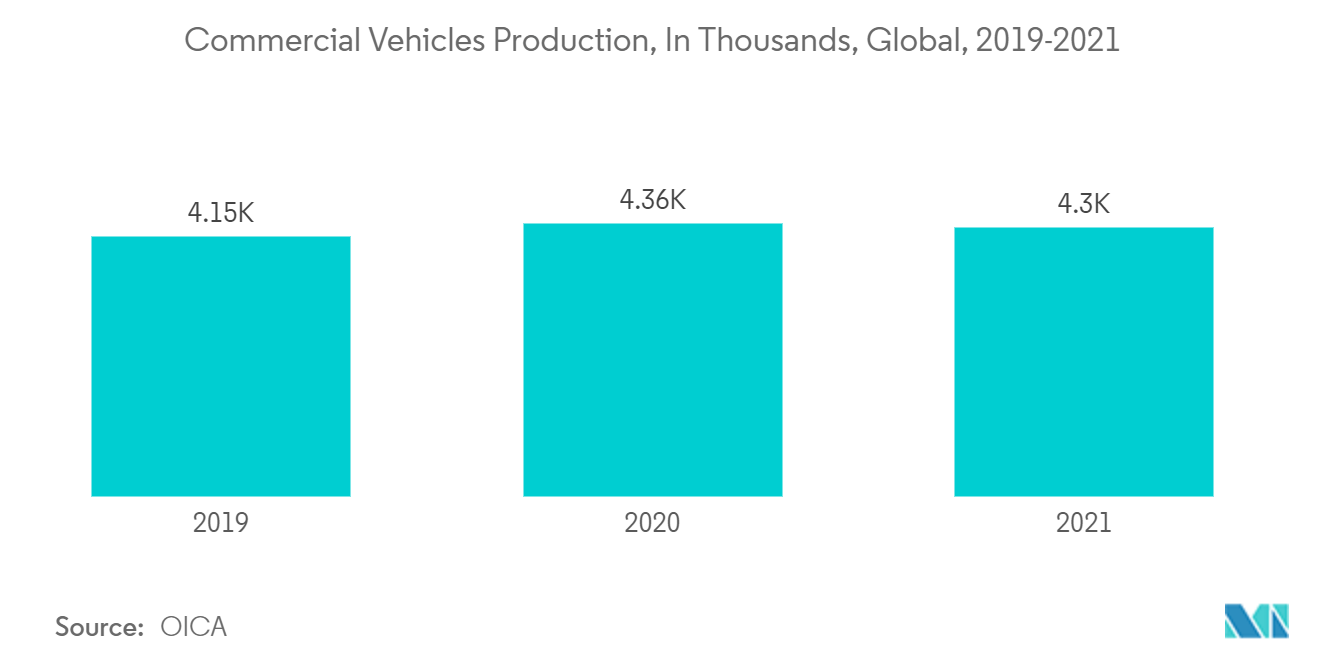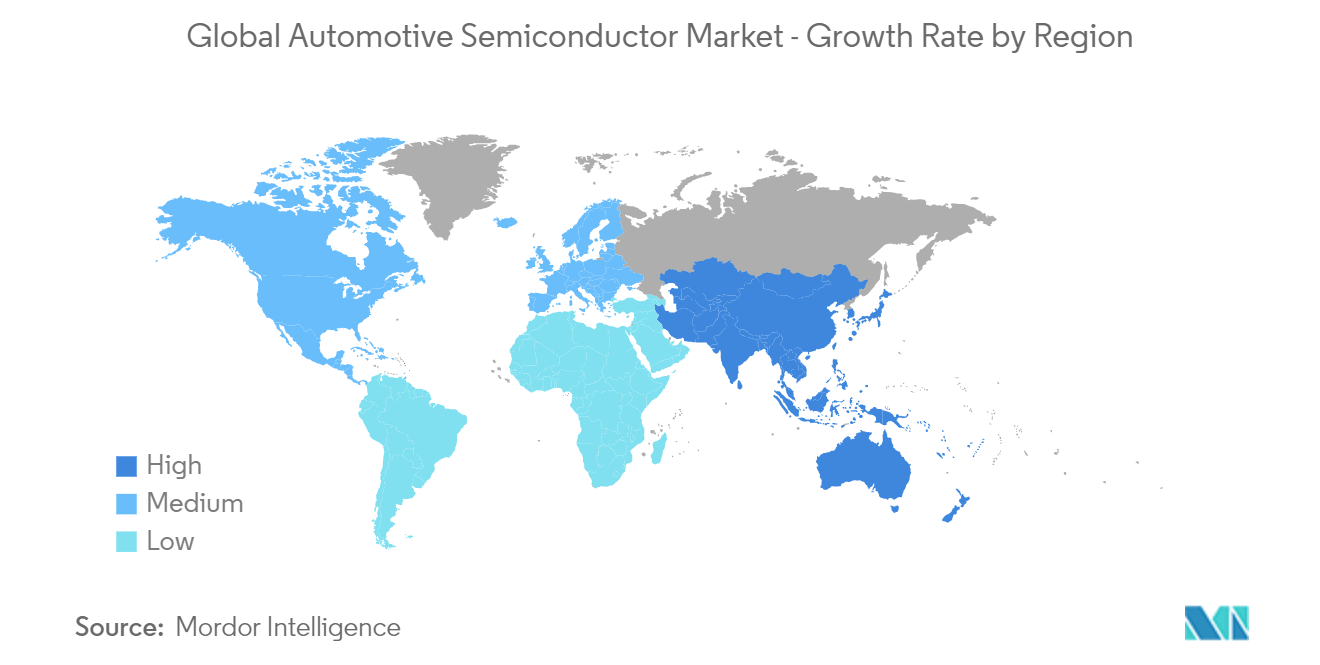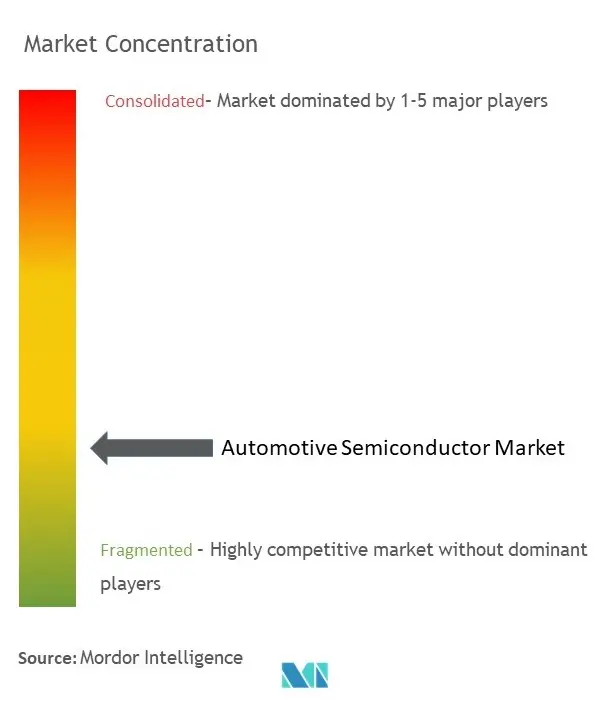Automotive Semiconductor Market Size

| Study Period | 2018 - 2028 |
| Market Size (2023) | USD 71.62 Billion |
| Market Size (2028) | USD 140.52 Billion |
| CAGR (2023 - 2028) | 14.43 % |
| Fastest Growing Market | Asia-Pacific |
| Largest Market | Asia-Pacific |
Major Players*Disclaimer: Major Players sorted in no particular order |
Need a report that reflects how COVID-19 has impacted this market and its growth?
Automotive Semiconductor Market Analysis
The Automotive Semiconductor Market size is expected to grow from USD 71.62 billion in 2023 to USD 140.52 billion by 2028, at a CAGR of 14.43% during the forecast period (2023-2028).
The market was evaluated by analyzing the market sizes of different components used in the automotive industry, including processors, sensors, memory devices, integrated circuits, and discrete power devices. The scope of the report comprises analyzing various vehicle types, like light commercial vehicles, heavy commercial vehicles, and passenger vehicles, around the world.
- A semiconductor is a substance, such as germanium or silicon, with electrical conductivity intermediate between a conductor and an insulator. The application of semiconductors in vehicles ranges from chassis, power electronics, safety, body electronics, and comfort or entertainment units, among others.
- Automobiles are an essential element of people's life because they are the primary form of transportation today. There are currently over 1.3 billion motor cars on the road worldwide, which is predicted to climb to 1.8 billion by 2035. Passenger automobiles account for around 74% of these figures, with light commercial vehicles and large trucks, buses, coaches, and mini-buses accounting for the remaining 26%.
- The technologies in automotive safety and security system have undergone a significant change in recent years, from seat headrests to adaptive cruise control systems. The rising wave of advanced technologies, such as blind-spot detection, drowsiness monitoring system, lane departure warning system, head-up display, night vision systems, park assist, e-call telematics, and tire-pressure-monitoring system technologies, are creating a significant potential for safety and security systems to protect the driver and passengers from serious injuries during a vehicle crash.
- A growing number of affordable vehicles feature advanced infotainment, safety, performance, and fuel efficiency. Such features lead to the inclusion of various components leading to an increase in the price raise of the overall vehicle. Thousands of semiconductor chips are at the core of automobiles today, acting as the vehicle's eyes, ears, and brain, monitoring the environment, making choices, and regulating actions. According to the Semiconductor Industry Association, modern automobiles may have 8,000 or more semiconductor chips and over 100 electronic control units, which currently account for more than 35% of total vehicle cost and are predicted to exceed 50% by 2025 to 2030.
- The COVID-19 caused an immediate halt in existing manufacturing, impacting supply chains around the world. China, which was initially afflicted by the pandemic, lost over two-thirds of its vehicle manufacturing owing to the statewide lockdown, which significantly damaged the supply chain. Auto supply chains are frequently geographically dispersed; with each country imposing its own protocol following the pandemic, supply chain management took a significant hit, emerging as one of the most critical challenges confronting the automotive industry during COVID-19.
Automotive Semiconductor Market Trends
This section covers the major market trends shaping the Automotive Semiconductor Market according to our research experts:
Heavy Commercial Vehicle Segment to Register Significant Growth
- The heavy commercial vehicle market is expected to register a significant CAGR during the projected period. With the introduction of modern technology, such as accident prevention systems, ADAS, efficient driving, and engine systems, and a focus on environmental sustainability and emission reduction, the demand for these large commercial vehicles is likely to increase in the future.
- Top manufacturers' technological advancements in heavy commercial vehicles are set to surge worldwide. A prominent trend characterizing the market's success has concentrated on accident prevention systems, automatic emergency braking systems, driver assistance, and blind-spot monitoring. Installing automated emergency braking systems and forward-collision warnings on heavy-duty vehicles may save more than 40% of rear-end incidents involving large trucks, according to research led by the Insurance Institute for Highway Safety (IIHS).
- According to the research, heavy-duty vehicles with front-crash prevention systems, such as automated emergency braking (AEB), had 12% fewer collisions, and forward-collision warning (FCW) had 22% fewer collisions. Consequently, the increasing demand for integrated ICs to make efficient automatic braking and driving systems is significantly driving the automotive semiconductor market worldwide.
- Under the new scrappage policy, governments in Asia-Pacific countries, like India, South Korea, and China, seek to push heavy-duty truck owners to acquire new heavy-duty trucks and other commercial vehicles, discouraging the use of old, polluting ones. The program would not only reduce pollution levels but also promote the advancements of the heavy-trucks segment in adopting integrated ICs, sensors , advanced microcontrollers, ADAS, and motor driver ICs, significantly influencing the growth of the market.
- To avoid paying high penalties for non-compliance with EU norms, several heavy-duty truck manufacturers in Europe have been investing in integrating novel technology to meet the zero-emission objective from 2025 onwards. The European Union has established carbon-neutrality goals and criteria for heavy-duty vehicles. These include a 15% decrease beginning in 2025 and increasing to 30% by 2030, with zero emissions by 2050.
- According to OICA, heavy commercial vehicle production in 2021 decreased by 1.51% compared with 2020 commercial vehicle production. Before the delta version caused a severe supply issue, chip producers, mostly in Asia, had ramped up manufacturing through the second half of 2021. Overall, the market is recovering after the pandemic.

Asia-Pacific to be the Fastest Growing Region
- The Asia-Pacific automotive semiconductor market is fueled by increased automotive manufacturing and continued partnerships between automotive OEMs and semiconductor manufacturers. Cost and fuel efficiency are no longer the most important factors to consider when buying an automobile; instead, the comfort and luxury offered by the vehicle are more important.
- This may be attributed to the fact that global automobile manufacturers are seeing strong demand for luxury and semi-luxury vehicles, which is pressuring them to install more electronic components, pushing the Asia-Pacific automotive semiconductors market. As a result of this reason, the Asia-Pacific automotive semiconductor industry offers a potential market area.
- The rapid expansion of the Asia-Pacific automotive semiconductor industry is expected to be fueled by the rising demand for electric vehicles. Automobile manufacturers must continue to innovate, create, and develop self-driving cars, which have already attracted a significant number of customers in key automotive manufacturing countries.
- The growth trajectory of fully-autonomous automobiles is expected to be heavily influenced by several factors, including technology advancements, consumer willingness to accept fully-automated vehicles, pricing, and suppliers' and OEMs' capacity to address major concerns about vehicle safety.
- According to the automobile industry, two-wheelers, three-wheelers, and tractors are in great demand across the country. In addition, India has a strong semiconductor R&D infrastructure, which may open up new potentials for the automotive semiconductor market in India in the future. Further, the government is taking various initiatives to boost the supply of semiconductor chips in the country. For instance, in September 2022, the Indian government announced to provide uniform fiscal support of 50% of the project cost for setting up semiconductor fabrication plants to boost semiconductor manufacturing in the country.

Automotive Semiconductor Industry Overview
The automotive semiconductor market is fragmented due to the presence of major players like NXP Semiconductor NV, Infineon Technologies AG, Renesas Electronics Corporation, STMicroelectronics NV, and Toshiba Electronic Devices& Storage Corporation (Toshiba Corporation) among others. Players in the market are adopting strategies such as partnerships, mergers, collaborations, innovations, and acquisitions to enhance their product offerings and gain sustainable competitive advantage.
In August 2022, Onsemi opened a silicon carbide (SiC) facility in Hudson, New Hampshire. The facility is expected to increase the company's production capacity by five times yearly and almost quadruple the number of employees in Hudson by the end of 2022.
In July 2022, NXP Semiconductors NV collaborated with Foxconn for a new generation of intelligent connected vehicles. The primary focus of the expanded collaboration is aimed at Foxconn’s efforts in electric vehicle (EV) platforms, leveraging NXP’s system expertise and comprehensive electrification portfolio, from NXP S32 processors to analog-front-end, drivers, networking, and power products. The collaboration would leverage NXP’s portfolio of automotive technologies and its longstanding expertise in safety and security to enable architectural innovation and platforms for electrification, connectivity, and safe automated driving.
In June 2022, Renesas Electronics Corporation partnered with Cyberon Corporation to provide voice user interface (VUI) solutions for customers using Renesas’ entire RA MCU line. The customers would get complimentary access to Cyberon’s command-based VUI toolchain, enabling them to add voice recognition to various endpoint applications in home appliances, building automation, industrial automation, wearables, and many more.
Automotive Semiconductor Market Leaders
NXP Semiconductor NV
Infineon Technologies AG
Renesas Electronics Corporation
STMicroelectronics NV
Toshiba Electronic Devices & Storage Corporation (Toshiba Corporation)
*Disclaimer: Major Players sorted in no particular order

Automotive Semiconductor Market News
- October 2022: Micron Technology Inc. intended to invest up to USD 100 billion over the coming 20-plus years to construct a new mega fab in Clay, New York, with the first phase investment of USD 20 billion planned by the end of the following decade. Micron’s New York mega fab is part of its strategy to gradually increase American-made leading-edge DRAM production to 40% of its global output over the next decade. Micron’s DRAM production in the United States brings tremendous benefits to its customers, enabling them to build innovative products.
- June 2022: NXP Semiconductors NV announced new processor families that extend the benefits of the company's innovative S32 automotive platform with high-performance real-time processing and safety. The S32E and S32Z and processor families help enable the automotive industry to accelerate the integration of diverse real-time applications for domain and zonal control, safety processing, and vehicle electrification that are critical to the next generation of safer and more efficient vehicles.
- June 2022: Renesas Electronics Corporation developed circuit technologies for 22-nm embedded STT-MRAM with faster read and write execution for microcontrollers in IoT applications. The test chip includes a 32-megabit embedded MRAM memory cell array and executes 5.9-nanosecond random read credentials at a maximum junction temperature of 150°C and a write throughput of 5.8-megabyte-per-second.
Automotive Semiconductor Market Report - Table of Contents
1. INTRODUCTION
1.1 Study Assumptions and Market Definition
1.2 Scope of the Study
2. RESEARCH METHODOLOGY
3. EXECUTIVE SUMMARY
4. MARKET INSIGHTS
4.1 Market Overview
4.2 Industry Attractiveness - Porter's Five Forces Analysis
4.2.1 Bargaining Power of Suppliers
4.2.2 Bargaining Power of Consumers
4.2.3 Threat of New Entrants
4.2.4 Intensity of Competitive Rivalry
4.2.5 Threat of Substitute Products
4.3 Industry Value Chain Analysis
4.4 Assessment of the Impact of COVID-19 on the Market
5. MARKET DYNAMICS
5.1 Market Drivers
5.1.1 Increasing Vehicle Production
5.1.2 Rising Demand for Advanced Safety and Comfort Systems
5.2 Market Restraints
5.2.1 Higher Cost of Advanced Featured Vehicles
6. MARKET SEGMENTATION
6.1 By Vehicle Type
6.1.1 Passenger Vehicle
6.1.2 Light Commercial Vehicle
6.1.3 Heavy Commercial Vehicle
6.2 By Component
6.2.1 Processors
6.2.2 Sensors
6.2.3 Memory Devices
6.2.4 Integrated Circuits
6.2.5 Discrete Power Devices
6.3 By Application
6.3.1 Chassis
6.3.2 Power Electronics
6.3.3 Safety
6.3.4 Body Electronics
6.3.5 Comforts/Entertainment Unit
6.3.6 Other Applications
6.4 By Geography
6.4.1 North America
6.4.2 Europe
6.4.3 Asia-Pacific
6.4.4 Latin America
6.4.5 Middle East and Africa
7. COMPETITIVE LANDSCAPE
7.1 Company Profiles
7.1.1 NXP Semiconductor NV
7.1.2 Infineon Technologies AG
7.1.3 Renesas Electronics Corporaton
7.1.4 STMicroelectronics NV
7.1.5 Toshiba Electronic Devices & Storage Corporation (Toshiba Corporation)
7.1.6 Texas Instrument Inc.
7.1.7 Robert Bosch GmbH
7.1.8 Micron Technology
7.1.9 Onsemi (Semiconductor Components Industries LLC)
7.1.10 Analog Devices Inc.
7.1.11 ROHM Co. Ltd
- *List Not Exhaustive
8. INVESTMENT ANALYSIS
9. FUTURE TRENDS
Automotive Semiconductor Industry Segmentation
Semiconductors are materials that have a conductivity between conductors (generally metals) and non-conductors or insulators (such as ceramics). Modern cars contain features like cell phone integration, heads-up displays, autonomous driving aids, comfort, and performance. As cars become even more complicated, demand for automotive semiconductors is expected to increase steadily and provide a powerful long-term growth engine for the automotive industry.
The scope of automotive semiconductors includes different functionalities of these semiconductor ICs in various automotive products. These features directly impact automobile sales, especially with the advancements in the automation industry, such as electrification and automation of automobiles. The various automobiles using semiconductors are passenger vehicles, light commercial vehicles, and heavy commercial vehicles. The applications of the semiconductors in these vehicles range from chassis, power electronics, safety, body electronics, and comfort/entertainment unit, among others. Different components of semiconductors considered as part of the scope of the study are processors, sensors, memory devices, integrated circuits, and discrete power devices, among others, across the globe. The study also covers the impact of COVID-19 on the market studied. The market sizes and forecasts are provided in terms of value (USD billion) for all the above segments.
| By Vehicle Type | |
| Passenger Vehicle | |
| Light Commercial Vehicle | |
| Heavy Commercial Vehicle |
| By Component | |
| Processors | |
| Sensors | |
| Memory Devices | |
| Integrated Circuits | |
| Discrete Power Devices |
| By Application | |
| Chassis | |
| Power Electronics | |
| Safety | |
| Body Electronics | |
| Comforts/Entertainment Unit | |
| Other Applications |
| By Geography | |
| North America | |
| Europe | |
| Asia-Pacific | |
| Latin America | |
| Middle East and Africa |
Automotive Semiconductor Market Research FAQs
How big is the Automotive Semiconductor Market?
The Automotive Semiconductor Market size is expected to reach USD 71.62 billion in 2023 and grow at a CAGR of 14.43% to reach USD 140.52 billion by 2028.
What is the current Automotive Semiconductor Market size?
In 2023, the Automotive Semiconductor Market size is expected to reach USD 71.62 billion.
Who are the key players in Automotive Semiconductor Market?
NXP Semiconductor NV, Infineon Technologies AG, Renesas Electronics Corporation, STMicroelectronics NV and Toshiba Electronic Devices & Storage Corporation (Toshiba Corporation) are the major companies operating in the Automotive Semiconductor Market.
Which is the fastest growing region in Automotive Semiconductor Market?
Asia-Pacific is estimated to grow at the highest CAGR over the forecast period (2023-2028).
Which region has the biggest share in Automotive Semiconductor Market?
In 2023, the Asia-Pacific accounts for the largest market share in the Automotive Semiconductor Market.
Automotive Semiconductor Industry Report
Statistics for the 2023 Automotive Semiconductor market share, size and revenue growth rate, created by Mordor Intelligence™ Industry Reports. Automotive Semiconductor analysis includes a market forecast outlook to 2028 and historical overview. Get a sample of this industry analysis as a free report PDF download.
